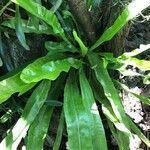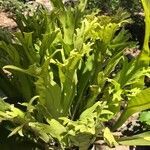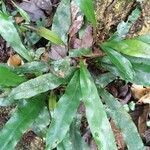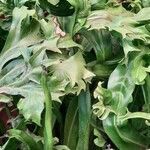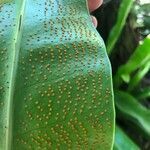Rhizome shortly creeping, subcylindrical, thick, 4-8 mm in diam., white waxy beneath scales. Scales pseudopeltate (sometimes peltate), appressed or slightly spreading, ovate or narrowly ovate or triangular, 1.5-8 × 0.5-3 mm, margin entire to denticulate to dentate, apex acute, clathrate or subclathrate, cells small, ± isodiametric or cells longitudinally rectangular, central region bearing multiseptate hairs at least when young or central region glabrous. Fronds not or slightly dimorphic. Stipe present or absent and lamina decurrent to its base. Lamina simple, narrowly obovate or narrowly ovate to narrowly elliptic to linear, 10-175 × 1.5-15 cm, herbaceous to subleathery (sometimes leathery), base narrowly decrescent, stipe winged for a considerable part to cuneate-decrescent or truncate to obtuse to cordate, auriculate, margin entire or undulate, apex acute to acuminate to rounded. Veins ± sunken and indistinct, or prominent and distinct. Sori separate, small, many, mostly irregularly scattered on smallest veinlets, in up to 8 irregular rows between costa and margin, up to 3 rows between adjacent costules, or some connate, elongate on veinlets, orbicular or elongate, superficial or slightly sunken, on whole surface of lamina or absent from basal parts; paraphyses with apical cell not enlarged.
Rhizome short-to long-creeping, not dorsiventrally flattened, sparsely scaly. Scales 1.5–4 mm long, 1–2.5 mm wide, ovate to broadly ovate, narrowed rather abruptly above rounded base; cells in central portion larger and thick-walled; marginal cells smaller and thin-walled; margins irregularly dentate; apex acute. Fronds scattered, c. 1 cm or more apart. Stipe indistinct; basal 0.5–3 cm unwinged. Lamina simple, narrowly elliptic, (14–) 27–113 (–150) cm long, 2.7–11 cm wide, pale green or yellow-green, coriaceous, glabrous, tapering to an acute or sometimes obtuse or rounded apex, narrowing gradually to base; margins entire or slightly undulate; midrib prominent, pale green or yellow-green; main lateral veins usually obvious, at least in dried fronds, angled at 60°–65° to rachis; remaining veins obscure. Sori numerous, 0.5–1.5 mm diam., scattered over lower surface of distal half of frond, not or only very slightly impressed into lamina. Spores 37.5–70 µm long, 22.5–40 µm wide. [See also Du Puy (1993: 547–548) for Christmas Island.]
Rhizome short-creeping, up to 4 mm in diam., covered with a thick felt of roots, phyllopodia distinct, apex densely scaled; scales clathrate, pseudopeltate, up to 8 x 2 mm. Fronds erect to arching, up to 1.5 m long. Stipe adaxially flatted, up to 12 x 8 mm, with few scales at base. Lamina simple, herbaceous, narrowly elliptic to oblong-acute, up to 1.4 m x 110 mm, adaxially punctate, near glabrous; venation evident or obscure, reticulate, areolae with included veinlets. Sori superficial, irregularly scattered, circular, up to 1.5 mm in diam., ± restricted to distal part of lamina; receptacle with 2-or 3-celled paraphyses; exindusiate.
Rhizome c. 8 mm in diameter, embedded in a thick felt of roots and set with dark grey entire, lanceolate-acuminate rhizome-scales c. 3 mm long. Fronds spaced c. 10 mm apart, simple, subsessile, thinly to thickly carnose-coriaceous; lamina elliptic to narrowly elliptic, up to 1 x 0.09 m, entire to irregularly undulate rounded, acute to acuminate; venation rather obscure, midrib prominent below. Sori numerous, minute, scattered over under surface of lamina, c. 1 mm in diameter.
A leafy fern. It has a slender creeping rhizome. It is fleshy. It is covered with a dense mass of black roots. The fern grows 0.3-1.2 m high. It can grow in soil or on rocks. The fronds are narrow and pale green. They are 30-120 cm long by 4-10 cm wide. They are leathery and undivided. They grow erect. Some varieties have lobed leaves. There are a range of cultivated varieties. The spore bodies are 0.1 cm across. They grow on the upper half of the fronds.
